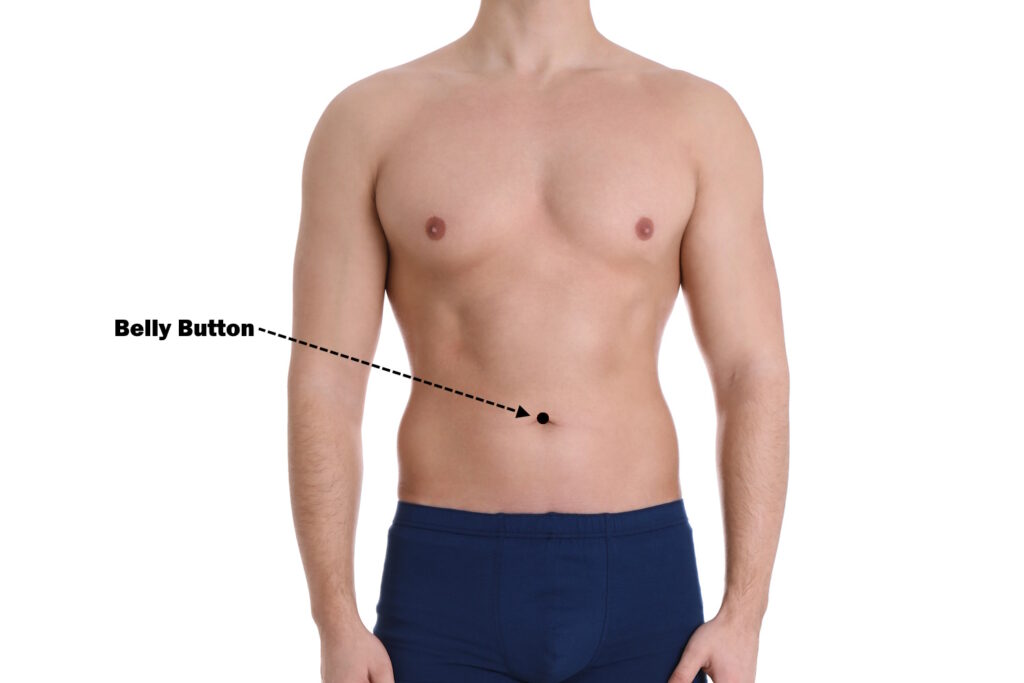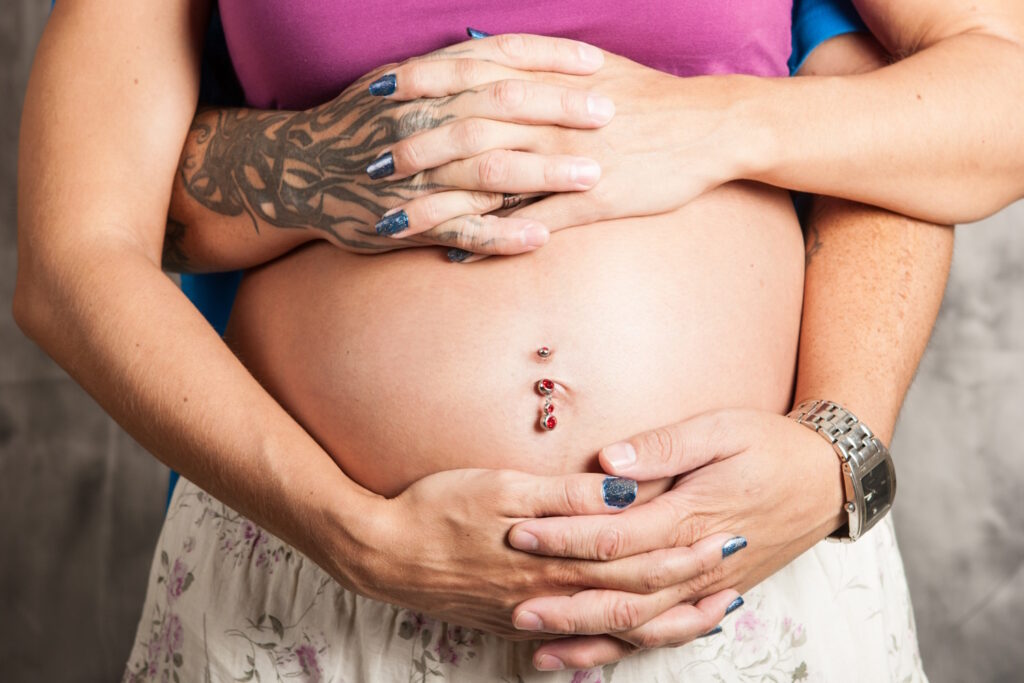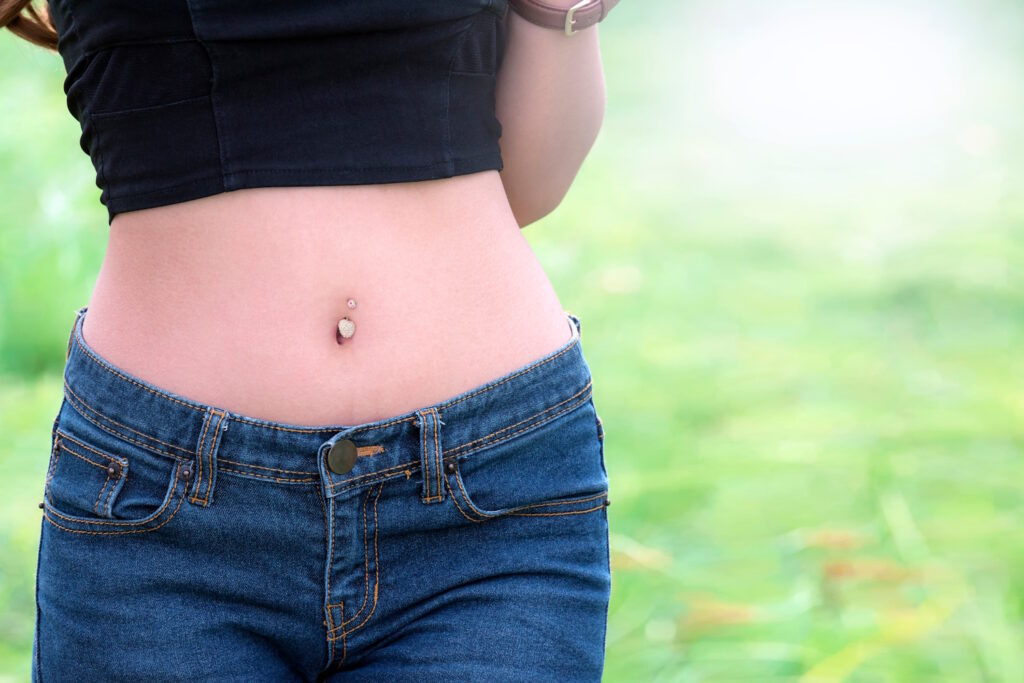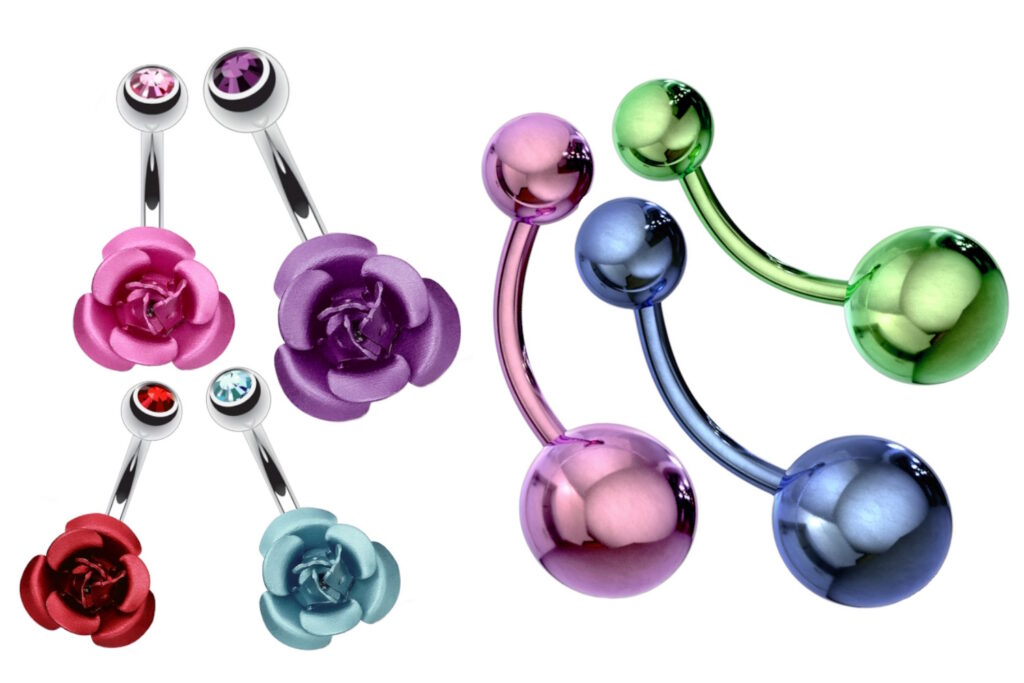
Belly Button Piercing: A Guide For Piercing Enthusiasts
Belly Button Piercing Article Quick Reference:
History | Myths | Complications | Pain | Cost | Procedure | Healing | Aftercare | Jewelry | Celebrities
A belly button piercing, also known as a navel piercing, has surged in popularity over the years, becoming a beloved form of self-expression and adornment for countless individuals. This tiny, yet impactful body modification not only serves as a fashion statement but also holds cultural significance in various societies around the world.
In this comprehensive guide, we will delve deep into the world of belly button piercings, uncovering the specific details, techniques, aftercare, and all the fascinating aspects that surround this intriguing form of body art.
Whether you’re considering getting your navel pierced or simply curious about the art and science behind it, this article is your one-stop resource for all things related to a belly button piercing. Let’s embark on a journey to discover the intricate and captivating world of this sought-after body modification.

A THOROUGH HISTORY OF NAVEL PIERCINGS
The history of belly button piercings is a rich tapestry that spans thousands of years and traverses various cultures. This form of body modification has evolved from ritualistic practices to a mainstream fashion statement. Let’s explore the comprehensive history of belly button piercings.
Belly button piercings have their roots in ancient cultures. The practice of body piercing, including navel piercings, can be traced back to the ancient Egyptians, who adorned their bodies with various forms of jewelry as a symbol of status and beauty. Scholars believe these early navel piercings, worn primarily by the pharaohs and the elite, became popular quickly.
In South Asia, particularly India, navel piercings have a long history and cultural significance. The practice is deeply rooted in Hindu traditions, where it is associated with fertility and marital status. Young women often received their navel piercings as part of coming-of-age rituals, and the jewelry worn in these piercings is known as “kamarbandh” or “waist chain.”
Belly piercings disappeared from Western culture for centuries but experienced a resurgence in the late 20th century. This resurgence is often attributed to the influence of popular culture, particularly music icons and celebrities who proudly displayed their navel piercings. One of the key moments was the appearance of supermodel Christy Turlington with a navel piercing on a 1993 cover of Vogue magazine.
The rise of professional piercing studios in the late 20th century made it easier and safer for individuals to get belly button piercings. As body piercings gained mainstream acceptance, more and more people began to explore this form of self-expression. The 1990s and early 2000s saw a surge in the popularity of belly button piercings among young adults and teenagers.
Today, they remain a popular and iconic form of self-expression, beloved by people of all backgrounds and ages.
MYTHS ABOUT BELLY PIERCINGS
There are several myths and misconceptions about navel piercings that are commonly believed. Here are a few:
- Myth – They Are Only for Certain Body Types: There’s a myth that navel piercings are only suitable for people with flat stomachs. In reality, navel piercings can be done on various body types and shapes.
- Myth – They Have A Quick Healing Process: Contrary to the belief that navel piercings heal quickly, they actually have a relatively long healing time, often taking several months to a year.
- Myth – They Have A High Risk of Infection: While all piercings carry some risk of infection, proper aftercare significantly reduces this risk. Navel piercings are not inherently more prone to infection than other types.
- Myth – They Limit Physical Activity: Some people believe that a navel piercing will limit their physical activity. While it’s important to be careful during the healing process, once healed, a navel piercing generally does not restrict movement or exercise.
- Myth – They Easily Reject Or Migrate: While rejection and migration can happen with any piercing, it’s not as common with navel piercings as some believe, especially with good aftercare and proper piercing techniques.
- Myth – They Are Only For Women: This is a gender-based myth. Navel piercings can be for anyone, regardless of gender, and they are becoming increasingly popular among all genders.
Remember, individual experiences with piercings can vary, and it’s always best to consult with a professional piercer for personalized advice and information.
BELLY BUTTON PIERCING POPULARITY
The popularity of belly button piercings varies based on age and gender, influenced by cultural, social, and personal factors. Here’s an overview: Gender Trends:
- Women: Belly button piercings are traditionally more popular among women. This trend is influenced by fashion and media portrayals, where female celebrities and models often showcase such piercings.
- Men: While less common, navel piercings among men have been gaining popularity. The rise in gender-neutral fashion trends and the increasing acceptance of body modifications in men contribute to this trend.
Age Groups:
- Teens and Young Adults: This age group, particularly those between 15 and 30, tends to have a higher prevalence of belly button piercings. This age range often coincides with a period of self-expression and experimentation with appearance.
- Older Adults: The prevalence decreases in older age groups. This decrease may be due to changing fashion trends, lifestyle changes (such as pregnancy, which can affect navel piercings), or shifts in personal preferences as people age.
In summary, while belly button piercings are particularly popular among young women, they are embraced by a wide range of people across different genders and age groups, influenced by personal taste, cultural trends, and changing societal norms.

BELLY BUTTON PIERCING RISKS
Getting a belly button piercing comes with several risks and potential complications, similar to other body piercings. It’s important to be aware of these risks before deciding to get a piercing. Common risks associated with belly piercings include the following:
- Infection: The risk of infection is one of the primary concerns with any piercing. Bacteria can enter the piercing site, leading to infections that might require treatment. Symptoms of infection include redness, swelling, pain, and discharge.
- Allergic Reactions: Some individuals may have allergic reactions to certain metals used in the piercing jewelry. Nickel is a common allergen.
- Rejection And Migration: The body may sometimes treat the piercing as a foreign object and push it towards the surface, leading to rejection or migration of the piercing. This can alter the appearance of the piercing and may even lead to its removal.
- Keloids And Scarring: Keloids are raised overgrowths of scar tissue that can develop at the piercing site. Some people are more prone to keloids than others. Even without keloid formation, any piercing can result in some degree of scarring.
- Nerve Damage And Pain: Incorrect piercing techniques or aftercare can lead to nerve damage or persistent pain in the navel area
To minimize these risks, it’s crucial to choose a reputable piercing studio, ensure that the piercer uses sterile equipment and techniques, and follow all aftercare instructions diligently. Consulting with a professional piercer about risks, aftercare, and suitable jewelry materials is always recommended before getting a belly button piercing.
BELLY BUTTON PIERCING COMPLICATIONS
Before getting a navel piercing, it’s also important to consider several health concerns to ensure it’s a safe and suitable choice for you. Here are some key health considerations:
- Existing Skin Conditions: A belly piercing may aggravate conditions like eczema, psoriasis, or dermatitis aggravates.
- Healing Capability: If you have a condition that affects your healing, such as diabetes or a compromised immune system, a piercing might take longer to heal and be more prone to infection.
- Blood Clotting Disorders: If you have a blood clotting disorder or take blood thinners, you may be at an increased risk of excessive bleeding from the piercing.
- Pregnancy Or Planning for Pregnancy: The navel area undergoes significant changes during pregnancy, which can affect an existing piercing or the healing of a new one.
It’s always a good idea to consult with a professional piercer to discuss these concerns and any others you might have. They can provide personalized advice based on your health, lifestyle, and the specifics of the piercing you want. Additionally, discussing your plans with a healthcare provider, especially if you have any pre-existing health conditions, is advisable.
WHAT SHOULD I DO IF I NO LONGER WANT MY NAVEL PIERCING?
If you decide you no longer want your belly button piercing, the process of removing it and allowing it to heal is generally straightforward, but there are important steps and considerations to keep in mind:
- Remove The Jewelry Carefully: If the piercing is fully healed, you can simply remove the jewelry yourself. Gently clean the area and your hands before carefully unscrewing or unclasping the jewelry. If you have any difficulty or the piercing is not fully healed, consider having a professional piercer remove it for you.
- Keep The Area Clean: After removing the jewelry, continue to clean the area regularly to prevent infection. Use a saline solution or gentle soap and water. Avoid using harsh chemicals or alcohol-based products, as these can irritate the skin.
- Monitor The Healing Process: Keep an eye on the piercing site as it heals. You should expect some closure and healing over time, but if you notice signs of infection (such as redness, swelling, pain, or discharge), consult a healthcare provider.
- Allow Time For Healing: The time it takes for a piercing hole to close varies depending on how long you’ve had the piercing and your body’s natural healing process. While the surface may appear healed quickly, deeper layers of tissue may take longer.
Remember, everyone’s body reacts differently, and the healing process can vary. If you have any concerns or questions, it’s always best to seek advice from a professional piercer or a healthcare provider.

HOW PAINFUL IS A BELLY PIERCING?
The pain experienced during a belly button piercing varies from person to person, as pain tolerance is highly individual. However, many people describe the sensation as a sharp pinch or pressure, lasting only a few moments during the actual piercing process. Here’s a general overview:
- Pain Level: Generally, belly button piercings are considered to be of moderate pain level compared to other types of piercings. The discomfort is usually brief.
- During Piercing: The most intense sensation occurs at the moment the needle penetrates the skin.
- After The Piercing: There may be some soreness, tenderness, and swelling around the piercing site for a few days to a week after the procedure.
To help manage the pain and discomfort, here are a few tips:
- Breathing Techniques: Deep, controlled breathing can help manage pain and anxiety during the piercing process.
- Pain Relief Medications: After the piercing, over-the-counter pain relievers like ibuprofen or acetaminophen can be used to alleviate discomfort. However, avoid taking aspirin as it can increase bleeding.
- Cold Compress: Applying a clean, cold compress to the area (not directly on the piercing) can help reduce swelling and soothe pain.
Remember, if you’re concerned about the pain, discussing your worries with the piercer before the procedure can help. They can provide more detailed information and reassurance. If the pain seems excessive or if you experience signs of infection or other complications after the piercing, seek medical advice.
HOW MUCH SHOULD I BUDGET FOR A BELLY BUTTON PIERCING?
The cost of a belly button piercing can vary based on several factors such as the location of the piercing studio, the experience of the piercer, and whether the price includes jewelry. Here’s a general idea of the cost in different regions of the United States:
- Midwest: The cost in the Midwest region can range from about $30 to $100. This variation depends on whether you bring your own jewelry or not, with an average price being around $40 without the jewelry.
- South: In the southern region of the U.S., you can expect to pay between $40 and $80 for a navel piercing, plus the cost of the jewelry.
- East Coast: The average cost for a belly button piercing on the East Coast is between $25 and $70. It’s important to note that the price of the rings is usually separate from the piercing service itself.
- West Coast: For example, in the West Coast area, specifically in California, the cost can vary. In the Bay Area, charges can be as little as $25 for the piercing, with jewelry priced at $15 and up. However, other places can charge $90 or more for a naval piercing that includes jewelry.
These prices can vary depending on the specific city and studio. It’s always a good idea to call ahead or check the website of the piercing studio for the most accurate and up-to-date pricing. Keep in mind that the overall experience, reputation of the studio, and the quality of the jewelry can also impact the price.
CHECK OUT THE BELLY PIERCING PROCEDURE
The belly button piercing procedure involves several steps to ensure safety, hygiene, and the best possible outcome. Here’s a detailed walkthrough of the typical process:
- Consultation:
- Discussion: The piercer will discuss your desired outcome, jewelry options, and any health concerns.
- Consent: You’ll likely fill out a consent form, confirming your agreement to the procedure.
- Preparation:
- Cleaning the Area: The piercer cleans around the navel with an antiseptic solution to minimize infection risk.
- Marking: The piercer marks the entry and exit points for the piercing.
- Choosing Jewelry:
- Selection: You’ll choose the jewelry, typically a curved barbell or ring, made from body-safe materials.
- Piercing Process:
- Gloves and Tools: The piercer puts on sterile gloves and uses sterilized tools.
- Clamping: A clamp might be used to hold the skin in place.
- Piercing: A sterilized, hollow needle is passed through the marked spot. This is typically done quickly to minimize discomfort.
- Inserting Jewelry: The jewelry is inserted immediately following the piercing.
- Post-Piercing Care:
- Cleaning: The area is cleaned again to remove any blood or debris.
- Aftercare Instructions: The piercer provides detailed aftercare instructions to ensure proper healing.
- Follow-Up:
- Check-Ins: It’s important to follow up with your piercer if you have any concerns or if complications arise.
Remember, the most crucial aspects of a piercing procedure are hygiene, the professional skill of the piercer, the quality of jewelry, and thorough aftercare.
BELLY BUTTON HEALING TIME
The healing time for this popular piercing can significantly between different people, but generally, it takes about 6 months to 1 year for a belly button piercing to fully heal. However, some key points to consider are:
- Initial Healing Phase: The first few weeks are crucial. During this time, swelling, redness, and some discomfort are common.
- Extended Healing Period: Even if the piercing seems healed on the outside, the internal tissue may still be healing. This extended period is vital for complete recovery.
- Individual Differences: From your overall health to your daily habits and cleaning routine, various factors actively influence how long your piercing takes to heal.
It’s important to follow the aftercare instructions provided by your piercer and to be patient with the healing process. Even if a piercing seems healed, it’s important to continue with aftercare practices to ensure complete and healthy healing.
AFTERCARE FOR THE NAVEL PIERCING
Aftercare for a navel piercing is crucial to ensure proper healing and prevent infection. Here are the general aftercare guidelines:
- Cleaning The Piercing: Clean the piercing at least twice a day with a saline solution or a gentle, non-antibacterial soap. Avoid using alcohol, hydrogen peroxide, or harsh cleansers as they can irritate the piercing.
- Hygiene: Always wash your hands thoroughly before touching or cleaning the piercing. Keep the piercing area clean and dry.
- Avoiding Irritation: Wear loose, breathable clothing to avoid irritation and pressure on the piercing. Avoid submerging the piercing in pools, hot tubs, or baths during the initial healing phase, as this can introduce bacteria.
- Sleeping: Be cautious when sleeping to avoid putting pressure on the piercing. Sleeping on your back might be most comfortable.
- Physical Activity: Limit activities that may cause friction or trauma to the piercing, such as certain sports or exercises.
- Handling Crusties: Do not pick or scratch at the crusties (the dried lymph) that form around the jewelry.
- Jewelry Maintenance: Avoid rotating or playing with the jewelry.
- Monitoring For Infection: Check for infection occasionally which may include excessive redness, swelling, pain, or discharge. If these occur, seek advice from a healthcare professional.
Following these aftercare instructions diligently can help ensure a smooth healing process for your navel piercing.

CHANGING THE STARTER JEWELRY
It’s most important to not change your starter jewelry until the piercing heals completely. Generally, you should wait at least 3 to 6 months. This is the minimum time you should wait before even considering a jewelry change. Even if the piercing seems healed externally, the internal tissue may still be healing.
However, this timeframe can vary based on individual healing rates and the absence of complications such as infection or irritation. Here are a few guidelines:
- Consult Your Piercer: Before attempting to change your jewelry for the first time, it’s advisable to consult with your professional piercer. They can assess whether the piercing is ready for the change and can also assist in the process, reducing the risk of injury or infection.
- Signs of Healing: Look for the absence of soreness, redness, swelling, and discharge. Aim for a comfortable, irritation-free zone around the piercing.
- First Change By A Professional: For maximum safety and expert advice, entrust your first jewelry change to a professional piercer.
It’s important not to rush the process, as changing the jewelry too early can lead to complications and prolonged healing times. Always prioritize the health and safety of your piercing.
JEWELRY METALS FOR THE BELLY PIERCING
Choosing the right belly piercing jewelry material for a piercing is crucial to ensure proper healing and to minimize the risk of allergic reactions and infections. The most recommended materials are:
- Surgical Stainless Steel: Particularly 316L or 316LVM surgical steel. It’s a common and affordable option, hypoallergenic for most people.
- Titanium: Specifically implant-grade titanium (ASTM F136) is a great choice due to its high biocompatibility and lower likelihood of causing allergic reactions.
- Niobium: Niobium, like titanium, boasts both hypoallergenic properties and the ability to be anodized for a vibrant spectrum of colors. It’s slightly heavier than titanium but equally safe for initial piercings.
- Solid Gold: At least 14K gold (not gold plated) is suitable for those without a sensitivity to gold. It’s important to avoid gold-plated or gold-filled jewelry as these can wear down and expose the skin to other metals.
- PTFE Or Bioplast: These flexible materials are good for people who have experienced allergic reactions to metals. They are also a good choice for pregnancy belly rings due to their flexibility and comfort.
Avoid materials like nickel, costume jewelry, and plated metals, particularly for fresh piercings, as they can cause allergic reactions or irritation. It’s always best to consult with your professional piercer to choose the most suitable material for your skin type and healing stage.
BELLY PIERCING JEWELRY DESIGNS
You call belly button jewelry “belly rings” or also “navel rings”. See the following suitable types:
- Curved Barbells: These are the most common and recommended types for belly piercings. They have a slight curve that comfortably fits the navel’s shape, minimizing irritation.
- Dangle Belly Rings: These have decorative pieces that hang from the bottom of the barbell. They are more suited for healed piercings due to their movement and weight.
- Banana Bells: Similar to curved barbells, but with a more pronounced curve, making them a comfortable and stylish option.
- Spiral Barbells: They have a spiral shape, adding a unique twist to the standard barbell design. Best used in healed piercings due to their shape.
Always prioritize your comfort and the healing process when choosing body jewelry for a belly button piercing. For initial piercings, it’s best to start with something simple and switch to more decorative options once healed.

CELEBRITIES WITH BELLY BUTTON RINGS
Belly button piercings have graced the bodies of many famous faces over the years, adding a touch of personality and edge to their style. Check out this list of ten celebrities who haven’t been shy about showing off their navel bling:
- Britney Spears
- Beyoncé
- Rihanna
- Jessica Alba
- Miley Cyrus
- Paris Hilton
- Kendall Jenner
- Lindsay Lohan
- Alicia Keys
- Christina Aguilera
From performances to red carpets to magazine spreads, celebrities like have actively showcased their belly piercings, contributing to their rise in popularity and mainstream acceptance within fashion and pop culture.
OPTING IN FOR A BELLY BUTTON PIERCING?
Belly button piercings, with their rich history, are a popular choice for those seeking both aesthetic appeal and personal expression. Unlike other piercings that target areas with cartilage, navel piercings typically involve a curved barbell and are known to be less painful during the procedure. But remember, aftercare is key! This healing process can take anywhere from 6 to 12 months, so be prepared to treat your new piercing with TLC.
By following proper hygiene guidelines and choosing the right jewelry, you can minimize risks like infection, rejection, and allergic reactions. Luckily, you have a variety of options to personalize your piercings for both style and comfort, from surgical steel to titanium.
It’s important to consider factors like pregnancy and metal sensitivities when deciding on and maintaining a belly button piercing. Overall, a belly button piercing can be a safe and satisfying choice when approached with care and informed decision-making. Decide if one is right for you today.
Do you have other questions related to belly piercings that weren’t answered here? Check out our belly button piercing FAQ.
Need to find a piercer? Check out the Association of Professional Piercers.
Author: Scott S.
